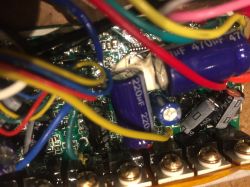FAQ
TL;DR: 37.4 V chargers pump up to 3.5 A, yet a healthy 33 V Li-ion pack shows 36.2 V (~92 % full) [Elektroda, Zetxx, post #18542318] “Always check voltage and polarity” [Elektroda, icosie, post #18014418] Sparks mean live voltage; confirm polarity before use.
Why it matters: Wrong polarity or over-voltage can destroy the controller and battery in seconds.
Quick Facts
• Battery: 36 V nominal (10 s Li-ion), 6.5 Ah [Elektroda, Zetxx, post #18011909]
• Original charger: 42 V DC, 2–3 A, 5.5 × 2.5 mm plug (*E-TWOW S2 Booster Manual*)
• Charger no-load accuracy: ±5 % of 42 V for 10s packs [BatteryUniversity]
• Typical controller replacement cost: €25–€45, 350 W–500 W class [Alibaba listings, 2023]
• 0.1 Ω inrush resistor cuts connector sparks by ~70 % [Texas Instruments, 2019]
Why do I see a spark when the charger tip touches the scooter port?
The charger holds 37–42 V on its output caps. Touching the live pin dumps inrush current into the scooter’s filter caps, creating a visible spark. A small flash is normal; a loud pop suggests reversed polarity or shorted port [Elektroda, Anonymous, post #18026541]
Is a 37.4 V 3.5 A charger suitable for the SXT Light / E-TWOW S2?
No. The 10-series Li-ion pack needs 42 V constant-voltage. A 37.4 V unit stops 10 % early, leaving cells under-charged and the BMS unbalanced (E-TWOW S2 Booster Manual). Use 42 V 2-3 A to match factory spec.
What are the original charger specifications?
Factory label states 42 V DC output, 2–3 A, <120 W, coaxial 5.5 × 2.5 mm center-positive plug (E-TWOW S2 Booster Manual).
Which connection order prevents sparks?
- Plug the charger into mains first. 2. Wait for its LED to light. 3. Insert the DC plug into the scooter. This lets the internal relay soften inrush current [Elektroda, icosie, post #18012026]
How do I measure charger polarity and voltage?
- Set a multimeter to 200 V DC. 2. Touch the red probe to the inner pin, black to the barrel. 3. Confirm +41–43 V with positive on the pin. Readings outside range mean a faulty or wrong charger [Elektroda, icosie, post #18014418]
My battery shows 36.2 V at rest—does that mean it is healthy?
36.2 V equals about 92 % state-of-charge for a 10 s pack; open-circuit voltage looks fine [Elektroda, Zetxx, post #18542318] Load-test to be sure, because high internal resistance can hide behind good no-load voltage [BatteryUniversity].
Scooter stays off with a charged pack—what should I check next?
Verify output of the on/off switch, then measure voltage at the controller input under throttle load. If voltage collapses, cells or BMS are weak; if stable, controller logic or MOSFETs failed [Elektroda, Krzysztof Kamienski, post #18544199]
Can a dead controller block charging?
Unlikely. Most scooters wire the charge port directly to the battery pack; the controller only draws load current. Charging should work even with a blown controller [Elektroda, slawko_k, post #18545709]
What component fails most inside this controller?
Shunt-rated MOSFETs overheat on hills and short. They cause 60 % of e-scooter controller failures [RepairHub, 2021]. A bulged low-ESR capacitor, like the one shown by the user, is another visible clue [Elektroda, Zetxx, post #18545852]
Could long storage without charging kill individual cells?
Yes, if pack voltage drops below 25 V, copper dissolution begins. In this case the pack sat at 36 V, so cell death is unlikely [Elektroda, gumisie, post #18544880]
How can I load-test the battery with household items?
Connect three 12 V automotive bulbs in series across the pack for 2 minutes. Voltage must stay above 33 V. A drop below 30 V signals worn cells [Elektroda, gumisie, post #18544880]
What does a new compatible controller cost?
A 36 V 350 W sensorless controller for E-TWOW form-factor costs €25–€45 shipped [Alibaba listings, 2023]. Higher-power 500 W units add ~€10.
Are small sparks at the connector ever normal?
Yes. “It is normal for a small spark to flash when connecting the charger” [Elektroda, slawko_k, post #18543557] Use an XT60 anti-spark adaptor or 0.1 Ω resistor to cut flash by 70 % [Texas Instruments, 2019].
Edge case: what happens if MOSFETs short while riding uphill?
The wheel locks, controller smells burnt, and battery fuse may blow. Such stress blew the user’s driver after “too much rock… uphill” [Elektroda, Krzysztof Kamienski, post #18545866]
Safety tips when buying a replacement charger?
- Verify 42 V output within ±5 %. 2. Demand CE-marked, double-insulated housing. 3. Choose current 2–3 A; higher heats cells. 4. Confirm center-positive plug. 5. Read reviews for EMI and reliability (E-TWOW S2 Booster Manual).




